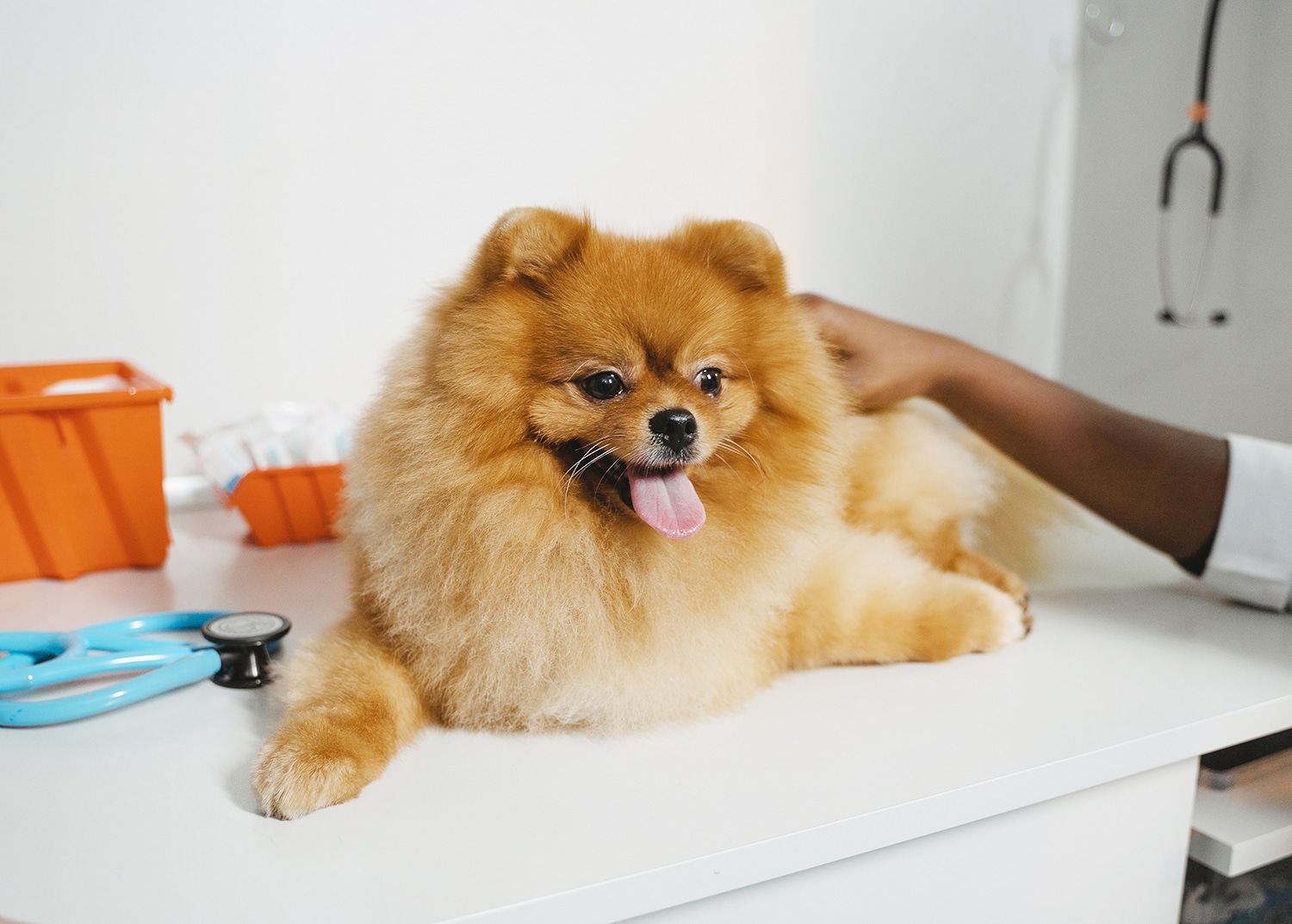Emergency situations can be scary, but they don’t have to be. The more prepared you are for emergencies, the less scary and stressful those situations tend to be. Let’s break down some common first aid scenarios including bleeding, heat stroke, poisoning, seizures and insect bites/stings along with what you can do before you can seek veterinarian help.
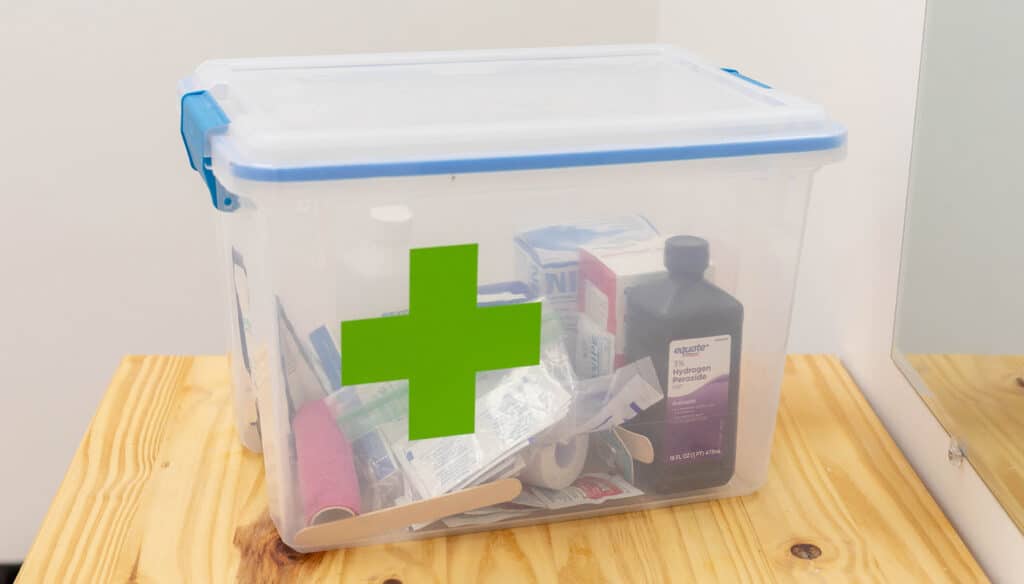
Bleeding
It’s important to remember that any animal can and will bite when in pain. It is recommended to muzzle your pet before attempting to stop bleeding or tending to any injury. If you do not have a muzzle, gently wrapping a belt, t-shirt, towel, etc. around the muzzle can help. Ensure your pet can still open its mouth to breathe.
When trying to stop bleeding, use the “rule of threes” – try each step three times. After the third attempt, it is time to move on to the next step in bleeding control.
Step 1:
Apply sterile gauze to the wound from your first aid kit and apply pressure. Hold pressure for three to five seconds and apply up to three times. If bleeding has subsided, lightly wrap with a gauze roll and transport to your vet. If bleeding persists, move on to step two.
Step 2:
If the area is still bleeding try holding pressure above the wound where the major artery is. This takes a significant amount of pressure and will be painful for the dog. If your dog has a bleeding injury near the knee or foot or rear leg, you would tightly squeeze its leg by its femoral artery. This can be found in the tuck up area, at the top of your pet’s legs where it meets the belly.
Hold pressure for approximately ten seconds and slowly release up to three times. If bleeding has subsided, wrap the wound with a gauze roll and knot it on top of the wound. You can wrap with vet wrap for extra support. The knot on top of the wound will add additional pressure to help keep pressure on the area.
If bleeding does not subside after three attempts, move onto step three.
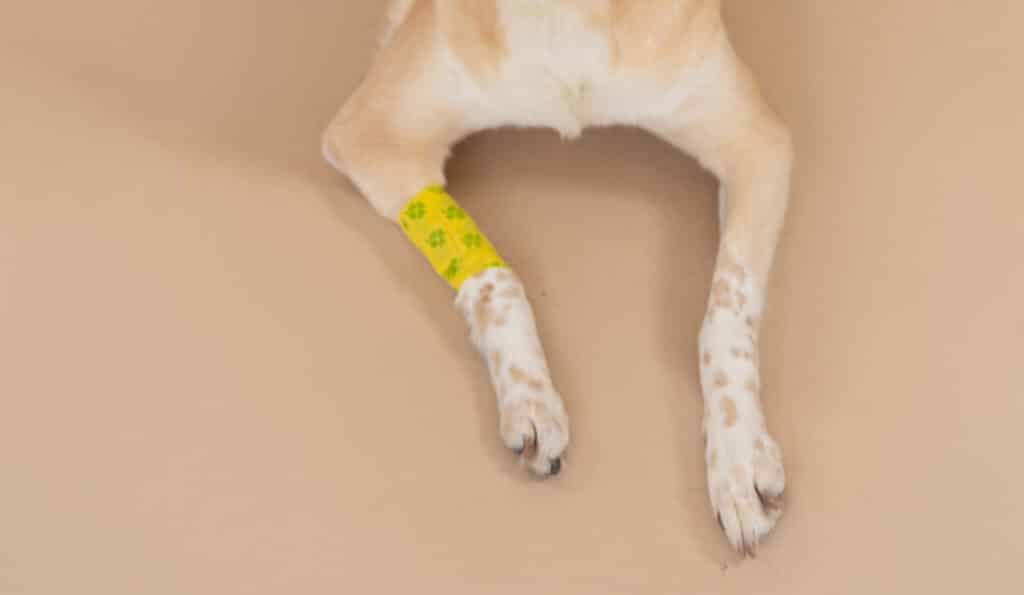
Step 3:
If you have tried the above steps and the bleeding has still not subsided, you will have to use a tourniquet. When dogs lose more than 30% of their blood, it can be fatal; it is important to get the bleeding to stop as quickly as possible. If you have reached step three, you will have to make the choice between life and limb. If your pet requires a tourniquet, it is extremely unlikely that the vet would be able to save the limb.
On that note, I personally have met several three-legged fur babies that are happy as can be! I know I would much rather save my pet than its leg if I had to make the choice.
To make the tourniquet, use anything long enough to tie around the leg. You will need to be as high on the leg as possible. Tie the belt, rope, leash, etc. around the uppermost part of the leg as tight as possible. Call the closest vet and transport immediately. Time is extremely important.
Heat Stroke
Heat stroke in dogs is defined as an internal body temperature of 103℉ and above. Extreme stress can also cause a pet to go into heatstroke.
Dogs cool themselves by panting. Brachycephalic breeds (such as Saint Bernards, Bulldogs, Pekinese, Shih Tzus and many others) are even more susceptible to heat stroke due to having more complications with breathing.
Heat Stroke Causes
Heat stroke is most often caused by leaving pets in a hot, confined space with little ventilation. High humidity and lack of water add to complications. It is of utmost importance to ensure pets have access to fresh, cool water at all times.

Signs of Heat Stroke
Uncontrollable panting, rapid heart rate, foaming at the mouth, lethargy, agitation, vomiting and loss of consciousness are all potential signs of heat stroke. If the pet’s tongue and gums are bright red, they could be in the beginning stages of heat stroke. If their tongue and gums turn gray or blue, it could mean the heat stroke has progressed into dangerous territory.
Capillary refill is checked by gently pressing on the gums and letting off pressure. If the color takes more than two seconds to come back, that is also a sign of heat stroke.
What to Do in Case of Heat Stroke
Step 1:
Keep the pet confined and restrained. Muzzle if it is thrashing or acting out. If muzzled, you must keep the pet cool as it will not be able to pant enough to keep itself cool.
Step 2:
Bathe or hose the pet off with cool water. Cold water will potentially send your pet into shock, so be sure it is just cooler than room temperature. You can also place the pet in a cool, ventilated area and wrap it in a cool, wet towel.
Step 3:
Use a digital thermometer to monitor your pet’s temperature. A dog’s normal temperature should be between 100.4℉ and 102.5℉. Be prepared to call the vet and transport immediately.

Poisoning
Poisons can be any liquid, solid or gas that can cause harm or death when ingested, inhaled, absorbed or injected into a pet. Dogs are three to four times more likely to be poisoned than cats due to their playful and curious nature.
Poisoning Causes
Careless handling or storing of potentially toxic chemicals is the most common occurrence of poisoning in both cats and dogs. Dogs and cats lick their paws, which makes them susceptible to poisoning, especially if they walk through insecticides, cleaning agents or petroleum based products.
The best approach is to avoid using toxic chemicals in or around your home. If you must, ensure they are stored properly and out of reach of curious pets and children.
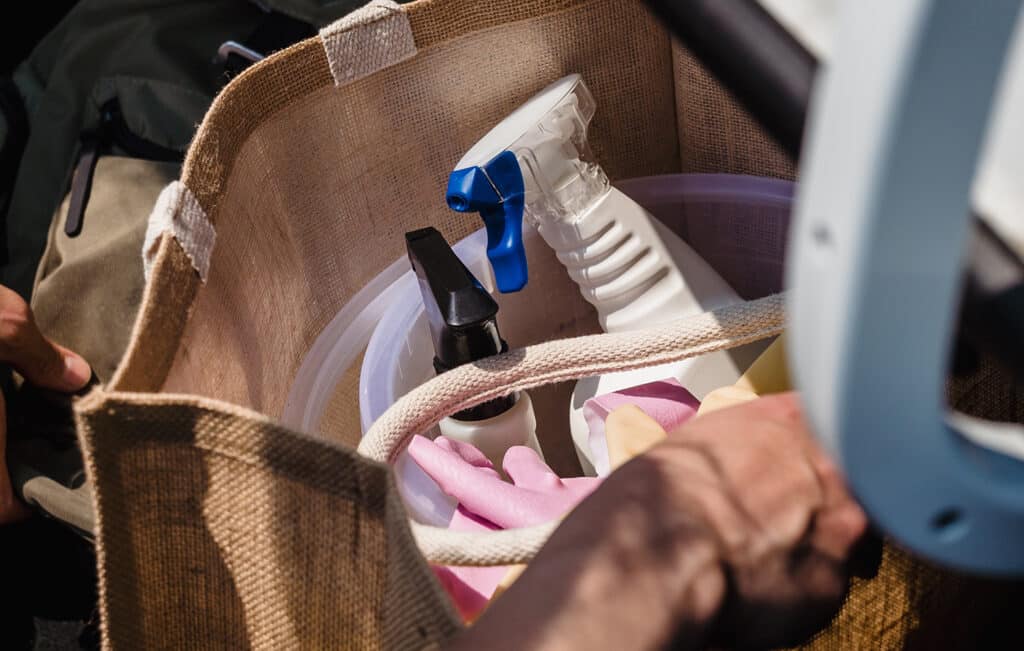
Common Plants Poisonous To Pets
(Either the root, seed, stem or leaves are poisonous)
Amaryllis
Apple Seeds
Avocado Seed
Azalea
Boxwood
Buttercup
Caladium
Cherry Pits
Crown of Thorns
Daffodil Bulbs
Daphne
Delphinium
Elephant Ear
English Ivy
Elderberry
Fox Glove
Holly
Hyacinth Bulbs
Hydrangea
Iris Bulbs
Jasmine Berries
Jimson Weed
Marigold
Marijuana
Mistletoe Berries
Mushrooms
Oleander
Peach
Philodendron
Poison Ivy
Privet
Rhododendron
Sago Palm
Stinging Nettle
Tobacco
Tulip Bulbs
Walnut
Wisteria
Yew

Common Household Products Poisonous To Pets
Acetaminophen
Aftershave
Antifreeze
Aspirin
Bleach
Boric Acid
Brake Fluid
Carburetor Cleaner
Cleaning Fluid
Deoderants
Deoderizers
Detergents
Disinfectants
Dye
Fungicides
Furniture Polish
Gasoline
Hair Colorings
Herbicides
Insecticides
Kerosene
Laxatives
Lead
Mineral Spirits
Mothballs
Nail Polish
Nail Polish Remover
Paint
Permanent Solution
Photo Developer
Rat Poison
Rubbing Alcohol
Shoe Polish
Sleeping Pills
Snail & Slug Bait
Soaps
Suntan Lotion
Tar
Toilet Bowl Cleaners
Turpentine
Windshield Washer Fluid
Wood Preservatives

Signs of Poisoning
Vomiting, diarrhea, excessive salivation, breathing difficulties, excitability, loss of consciousness and seizures are all potential signs of poisoning. Initially your pet may seem fine, but they can deteriorate extremely fast. Loss of consciousness and breathing can happen quickly.
What to Do if Your Dog is Exposed to Poison
Stay calm. If poisoning is suspected, the most important thing to do is some investigation. The more information you know about what your pet got into and how much they potentially ingested, the better.
Treatment for poisoning requires quick first aid and prompt veterinarian care. Medical care from a veterinarian is vital, because the amount of poison ingested is typically unknown.
Step 1:
Determine the substance of the poisoning. Take all of the packaging if possible.
Step 2:
Determine the time the pet was exposed to the substance.
Step 3:
If the pet vomited or has had diarrhea, collect a sample for the vet.
Step 4:
Contact your veterinarian and/or Animal Poison Control. Vomiting should only be induced at the recommendation of poison control or your vet. If the substance is petroleum based, a strong alkali or acid, do not induce vomiting.
Animal Poison Control | (888) 426-4435 | ASPCA. There is a small fee on a per-case basis. The call center takes all major credit cards.
Step 5:
If the suspected substance is toxic or corrosive on the surface of the pet’s body, you should immediately begin to flush it with copious amounts of water. Some chemicals react to water, so dry brush chemicals off prior to irrigation.
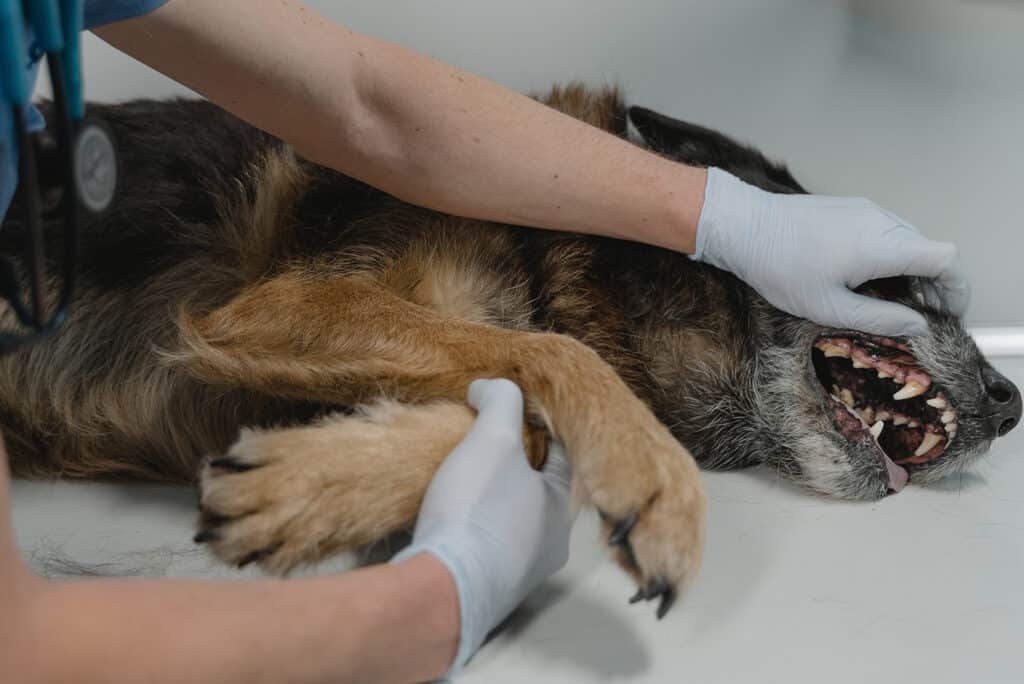
Seizures
Seizures are defined as involuntary contractions of muscles caused by abnormal cerebral stimulation or dysfunction.
Causes of Pet Seizures
Seizures can be caused by epilepsy, poisoning or head trauma. There are many toxic chemicals that can cause seizures in dogs and cats. Head trauma in dogs usually consists of a pet falling (typically out of a car) or being hit by a car. Epilepsy is extremely rare in cats.
Signs of a Seizing Pet
Possible symptoms include falling, chomping jaws, stiffening of the body, paddling motion of the legs, and jerky or uncontrollable movements lasting more than two minutes. Before and after a seizure, pets can have a low level of consciousness. It is not uncommon for a pet to seem to not know where they are or who their owners are for some time prior to and after a seizure. The pet may empty its bowels after a seizure as well.

What to Do if Your Pet Has a Seizure
Stay calm! Reduce external stimuli such as lights, sounds and people. Do NOT restrain the pet or place anything in its mouth. If the pet is in an unsafe location, very carefully attempt to move it to a clear area on the floor. If possible pull any object that may harm the pet out of the way.
Step 1:
Place a rolled blanket or towel under the head for protection.
Step 2:
When the seizure has stopped, monitor your pet’s breathing. If there is no history of seizures, transport to a vet or emergency animal hospital. If the pet has a history of seizures, make note of this seizure and continue to monitor.
Step 3:
Keep your pet in a cool, comfortable, dark place.
Step 4:
Clean up any messes and make note of the duration and frequency of seizures. If the seizure lasted longer than “normal” for your pet, call your vet immediately.
Note: Keeping records of seizure length, frequency and surroundings is vital in maintaining the health of an epileptic dog.
Insect Bites and Stings
Ants, bees, hornets, wasps, spiders and snakes can bite or sting pets, especially extra curious pets that tend to put their noses in or around overgrown brush.
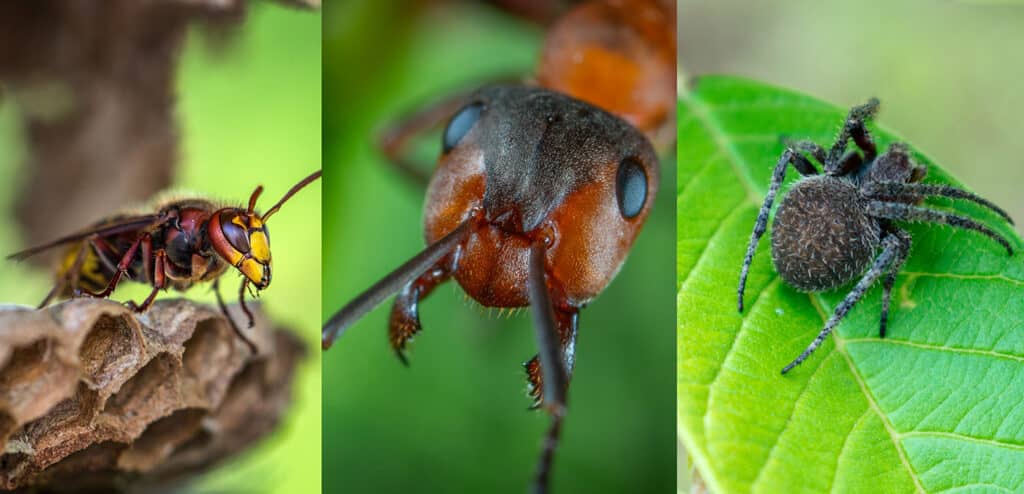
Bite and Sting Causes
There are several biting or stinging insects that live in holes or colonies, therefore increasing the chances of multiple bites or stings. Unless you see your pet being bit or stung or notice a severe allergic reaction, you will likely not be immediately aware of why your pet is having problems.
Signs of Insect Bites and Stings
Pain, redness and localized swelling at the bite or sting is common. Your pet may paw, lick or scratch at the site of the sting or bite. Bites and stings are not typically life threatening unless your pet has a severe allergic reaction.
What to Do if Your Pet is Bit or Stung
Treat your pet’s symptoms as they present themselves and do what you can to make your pet comfortable. Apply an antihistamine lotion or calamine cream to the affected areas. Benadryl may be administered at the recommendation of your veterinarian.
Step 1:
Immobilize and confine your pet for observation and reduce its level of activity. If muzzled, be prepared to loosen or remove it.
Step 2:
Identify insects if possible and remove the stinger if present.
How to remove a stinger: Grabbing a stinger with tweezers or your finger could inject more poison into your pet. It is best to use the hard edge of a credit card or key. Place the card or key under the stinger to lift it up then flick it out.
In the Grooming Salon
Grooming salons can be a stressful environment for pets. While emergencies are luckily rare, it is extremely important for us to be prepared as professional dog groomers.
At Smoochie Pooch, we pride ourselves on having all members of our team as prepared as possible by having the Pet Tech CPR & First Aid certification for pet professionals. Though rare, heat stroke and seizures are the most common occurrences seen in a salon; in the event of an emergency, we are ready to help the pets in our care.
Elli Bultemeier, PTI, NCMG



